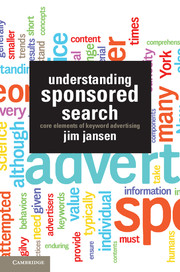Book contents
- Frontmatter
- Contents
- Preface
- Acknowledgments
- Notes on Terminology
- 1 A Context for Sponsored Search
- 2 Modeling the Process of Sponsored Search
- 3 Understanding Customer Intent for Keyphrase Selection
- 4 Sending Signals to the Customer with Ads
- 5 Understanding Consumer Behavior for Sponsored Search
- 6 BAM!: Branding, Advertising, and Marketing for Sponsored Search
- 7 Sponsored-Search Analytics
- 8 The Serious Game of Bidding on Keywords
- 9 Bringing It All Together in a Framework of Sponsored Search
- 10 The Future of Sponsored Search
- Glossary
- Index
- References
4 - Sending Signals to the Customer with Ads
Published online by Cambridge University Press: 05 August 2011
- Frontmatter
- Contents
- Preface
- Acknowledgments
- Notes on Terminology
- 1 A Context for Sponsored Search
- 2 Modeling the Process of Sponsored Search
- 3 Understanding Customer Intent for Keyphrase Selection
- 4 Sending Signals to the Customer with Ads
- 5 Understanding Consumer Behavior for Sponsored Search
- 6 BAM!: Branding, Advertising, and Marketing for Sponsored Search
- 7 Sponsored-Search Analytics
- 8 The Serious Game of Bidding on Keywords
- 9 Bringing It All Together in a Framework of Sponsored Search
- 10 The Future of Sponsored Search
- Glossary
- Index
- References
Summary
Just be sure your advertising is saying something with substance, something that will inform and serve the consumer, and be sure you’re saying it like it’s never been said before.
Bill Bernbach, cofounder of Doyle Dane Bernbach (DDB), a worldwide creative advertising agencyBernbach [1] was a pioneer in the modern advertising field, and as the quote in the epigraph states, advertising is about informing the customer with relevant information that addresses a need and is presented in an attention-getting manner. These are the factors critical for any advertising endeavor.
- Type
- Chapter
- Information
- Understanding Sponsored SearchCore Elements of Keyword Advertising, pp. 60 - 83Publisher: Cambridge University PressPrint publication year: 2011



